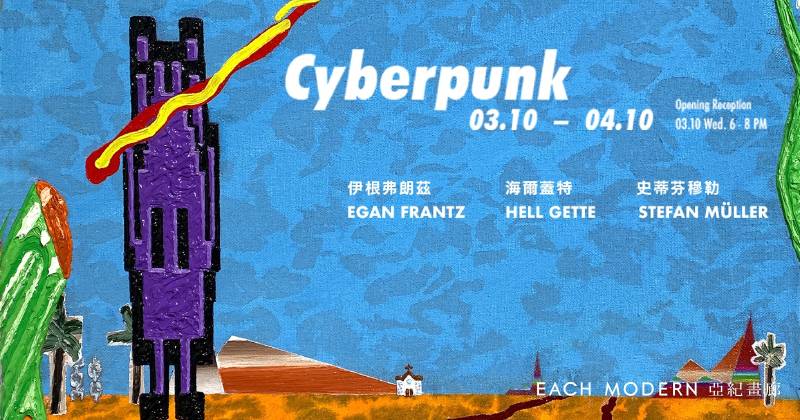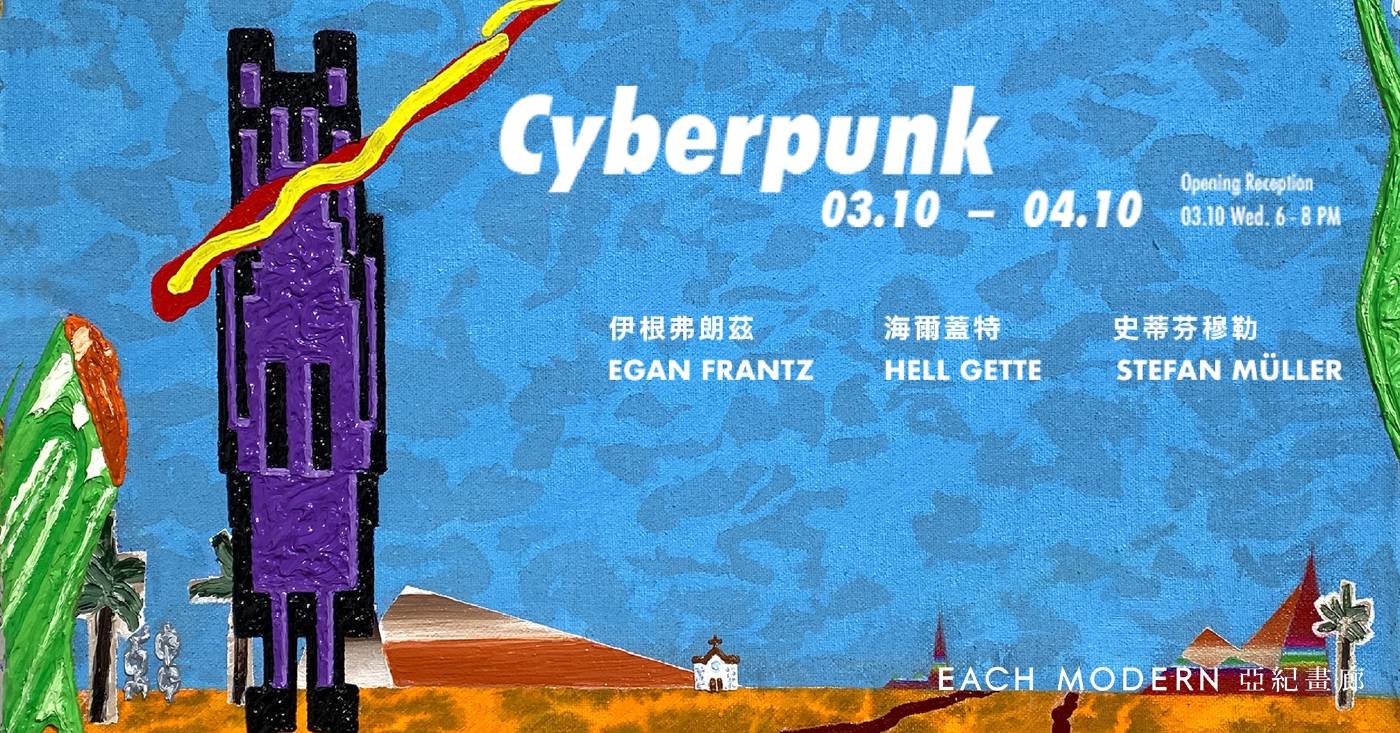亞紀畫廊
【 Cyberpunk】伊根弗朗茲、海爾蓋特、史蒂芬穆勒

-
展期
日期:2021-03-10 ~ 2021-04-10
-
地點
台北市大安區信義路四段156號
-
參展藝術家
伊根弗朗茲、海爾蓋特、史蒂芬穆勒
-
《 Cyberpunk 》
伊根弗朗茲 Egan Frantz
海爾蓋特 Hell Gette
史蒂芬穆勒 Stefan Müller
⠀⠀⠀⠀
March 10 – April 10, 2021
Opening Reception: March 10, 2021 | 6-8 PM
⠀⠀⠀⠀
Each Modern 亞紀畫廊很高興宣布國際藝術家群展「Cyberpunk」,帶來伊根弗朗茲、海爾蓋特、以及史蒂芬穆勒的最新作品。三位藝術家曾在 2020 年在台北國際藝術博覽會首次亮相,並造成轟動。
⠀⠀
美國作家布魯克貝斯克(Bruce Bethke)在 1980 年代創造了詞彙「賽博龐克」(Cyberpunk),從此這概念被廣泛運用在了文學、電影、電玩、音樂、甚至建築中。賽博龐克的世界通常是一個極致的科技主義與資本主義社會,所有的文化、記憶、肉體、與思想都成為了數位化的符碼,並由超大型企業或政府掌控與分發。他們在數位世界建立高端科技、文化平等的美好,而人們卻在破敗的現實中過著低端而不等的生活。也因此,賽博龐克的世界通常也伴隨著中下階級的反動。
⠀⠀
我們可以在電影《銀翼殺手》及《駭客任務》、動漫《攻殼機動隊》及《阿基拉》、甚至去年甫發行的電玩《電馭叛客2077》中一探賽博龐克世界的瘋狂景色。就如同其他科幻小說中的幻想都在現代一一實現,賽博龐克也因為我們對該概念的著迷與幻想而逐漸現實在了生活中 — 無論是對科技世界的烏托邦憧憬,還是對破壞秩序的反烏托邦想像,又或者氾濫的賽博龐克產物早已預示了不遠的將來。
⠀⠀
本次群展中的伊根弗朗茲、海爾蓋特、與史蒂芬穆勒出生於賽博龐克啟蒙時期,在後現代主義的文化與情緒環境中成長。這三位藝術家不建構典型的賽博龐克風景,而是以不同的型態語彙表達對文化經驗、符號意圖、形上啟示的渴望 — 這些都指向未來,形象化了在多元、複雜、追求全面進步的社會中可能發生的解放。
⠀⠀
伊根弗朗茲(1986 年生於美國諾沃克)來自美國的音樂家庭,父母親為知名新浪潮樂團「Talking Heads」成員。在伊根弗朗茲的繪畫中,他經常將大量的音樂、文學、神學典故編碼成幾乎不可解讀的符號。2021 年的文字繪畫系列則先經由電腦繪圖設計草稿,再進行實際的繪畫。於此,數字編碼產出了繪畫的內容。而即使我們能試圖猜測這些「文字」是關於什麼:日文、塗鴉、或專輯封面?我們無法證據確鑿的指明。佛朗茲認為,這樣的繪畫傳遞的是一種超越書寫系統的視覺經驗,如《文字遊戲》的低文化、漫畫感、可樂紅、與電腦字體暗示。它們看似我們所熟悉的語言,卻又不帶有任何語言的意義,每一個零碎的筆畫組合成了神秘的全貌。他在抽象與寫實中處理繪畫,也如同賽博龐克世界中的矛盾 — 虛擬與真實的辯駁,從而不可知而全知。
⠀⠀
海爾蓋特(1986 年生於哈薩克卡拉布拉克)為來自哈薩克的難民移民,現居德國慕尼黑。年輕的她曾在訪談中回想起故鄉家後院的花園,那些她不再能見到的植物、空氣、昆蟲。祖國、難民營,幾次世界的轉換改變她面對世界的真實感,但所謂的現實也無法評斷是最好的生活 - 這些彷彿是賽博龐克故事的核心命題。海爾蓋特告知我們即將生活在一個未來中,是原始、物質、本質越來越黯淡、越來越被虛擬的、媒介化、投射化的現實所取代。在這些現實中,事物被複製並以無盡的扭曲鏈條再重新複製。當人類的感受與記憶都能以數碼化的圖像表現之後,這些由虛擬圖案所建構的風景也將逐漸的成為無法分辨真假的情況。最終,虛擬侵入到了現實之中。
⠀⠀
史蒂芬穆勒(1971 年出生於德國法蘭克福)是一位涉獵哲學與音樂的藝術家,並將它們轉化成為他的繪畫特色:德國哲學家狄奧多阿多諾(Theodor Adorno)認為藝術作品是一個封閉的自我實體,有自己的自身法則與結構邏輯,如同哲學理論的「非同一性」,藝術作品的概念、概念的指涉物、作品本身是處在三條不平行的線向上,也就是說作品本身優先於任何知識概念的介入而已存在與此。因此,史蒂芬穆勒的作品純粹到幾乎無法評論,他對細節、布料、材料、顏料的處理顯現了繪畫作為存在的意義本身。我們可以將穆勒的畫作視為一種極端情況下的無動於衷,或回歸更為自我表現的媒材運用。以本質的樸實無華,斷開與數位世界的緊密連結,對抗仰賴資本與流量的當下社會。
⠀⠀
Each Modern is pleased to announce “Cyberpunk,” a group exhibition presenting new works by three artists who showed in Taiwan for the first time last year and brought a great sensation to the 2020 edition of Art Taipei.
⠀⠀
The term “Cyberpunk” first appeared in the American author Bruce Bethke’s story in 1980. Since then, the term has been widely used in literature, movies, video games, music, and even architecture. A cyberpunk world is usually an extremely technological and capitalist society. Cultures, memories, bodies, and ideas have become like digital codes, controlled and distributed by a megacorporation or the government. They constructed sprawling urban worlds of the distant future, often built with glittering technology and cultural hegemony, yet teaming with masses living in derelict conditions. A stark disparity and inequality serve as a basis of these fantasies. As such, a cyberpunk world is an inevitable confrontation with the working and middle classes against omnipotent elites.
⠀⠀
Like many once-lofty dreams born from science fiction, the world of cyberpunk has gradually become our reality (if not in actuality, then in appearance at the very least). We are drawn by this conceptual mirage and illusion— whether it’s a utopian vision of a technologically advanced world, or the dystopian vista of broken order. Perhaps the proliferation of cyberpunk, and its simulations and products, has already foreshadowed our near future.
⠀⠀
Born in the illumination of Cyberpunk, Egan Frantz, Hell Gette, and Stefan Müller grew up in a culturally and emotionally postmodernist environment. The three artists do not create typical cyberpunk landscapes, but express their desire for cultural experience, semiotics, and metaphysics in different ways — all of these guide us towards a kind of future and visualize a possible liberation of a diverse, complex, and progressive society.
⠀⠀
Egan Frantz(born in Norwalk, USA in 1986) is an artist connected in multiple ways to contemporary music. In Egan Frantz's paintings, he encodes music, literature, and theology into indecipherable symbols. In the 2021paintings, Frantz makes the digital sketch on the computer before he actually paints. From there, the digital code generates the appearance of the painting, similar to how code creates cultural content in the world of cyberpunk. We could probably guess what these "words” are about: Japanese characters, graffiti, or album covers, we are not able to specifically recognize any of them. For the artist, what the paintings convey is a visual experience beyond any writing system, such as the comic, Coca Cola red, and graphic font in “Word Play”(2021). When Frantz experiments in abstract paintings, both virtually and realistically, it is like how the virtual and reality try to coexist with each other, like the cyberpunk world, unknowable and omniscient.
⠀⠀
Hell Gette(born in Karabulak, Kazakhstan in 1986) is a refugee immigrant currently living in Munich, Germany. In past interviews, she has reminisced on the backyard garden of her hometown and the plants, air, and insects that she can no longer see. The motherland, the refugee camp, and the severe changes of the world alter how she sees her reality – a world that we can no longer evaluate within our present circumstance, as the world of cyberpunk often brings us escape to more idyllic views virtually. Gette’s works inform us of a future where the primitive, the material, and the essential are made bleak and replaced by virtual, mediated, and projected realities. In these realities, things are reproduced in endless twisted chains. When we are able to express our feeling and memories through digitally coded emojis, her world, built by the virtual images, will gradually become plausible. Then, eventually, it bleeds into reality.
⠀⠀
Stefan Müller (born in Frankfurt, Germany in 1971) is an artist whose experience with philosophy and music, have both been transformed into the characteristics of his painting. German philosopher Theodor Adorno has written that the work of art is a closed self. It has its own disciplines and structural logic like "non-identity" in philosophical theory. The concept of a work of art, the referent of the concept, and the work itself, is on three non-parallel lines, so the existence of the work itself precedes the intervention of any knowledge and notion. Therefore, Müller's works are so pure that it is almost impossible to comment. His handling of details, fabrics, materials, and pigments presents the meaning of painting itself. We can say Müller’s paintings stay indifferent in the extreme situation, or his practice is more about returning to self-exploration of the media. With the essence of simplicity, the artist disconnects with the digital world and opposes the current society that depends on capitalism and popularity.
